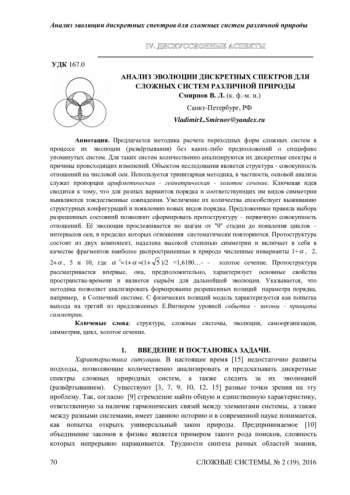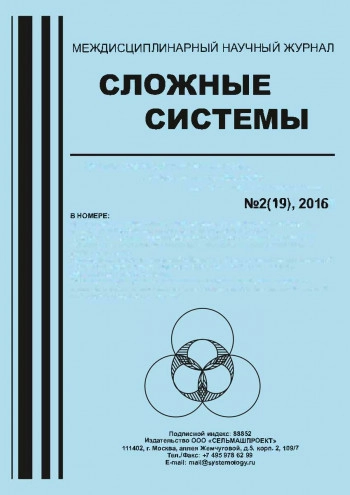Предлагается методика расчета переходных форм сложных систем в процессе их эволюции (развѐртывания) без каких-либо предположений о специфике упомянутых систем. Для таких систем количественно анализируются их дискретные спектры и причины происходящих изменений. Объектом исследования является структура - совокупность
отношений на числовой оси. Используется тринитарная методика, в частности, основой анализа служат пропорции арифметическая - геометрическая - золотое сечение. Ключевая идея сводится к тому, что для разных вариантов порядка и соответствующих им видов симметрии выявляются тождественные совпадения. Увеличение их количества способствует выживанию структурных конфигураций и появлению новых видов порядка. Предложенные правила выбора разрешенных состояний позволяют сформировать протоструктуру – первичную совокупность отношений. Еѐ эволюция прослеживается по шагам от “0” стадии до появления циклов – интервалов оси, в пределах которых отношения систематически повторяются. Протоструктура состоит из двух компонент, наделена высокой степенью симметрии и включает в себя в качестве фрагментов наиболее распространенные в природе численные инварианты 1+ , 2, 2+ , 5 и 10, где -1=1+ =(1+ 5 )/2 =1,6180…- - золотое сечение. Протоструктура рассматривается впервые, она, предположительно, характеризует основные свойства пространства-времени и является сырьѐм для дальнейшей эволюции. Указывается, что методика позволяет анализировать формирование разрешенных позиций параметра порядка,
например, в Солнечной системе. С физических позиций модель характеризуется как попытка выхода на третий из предложенных Е.Вигнером уровней события - законы - принципы симметрии.
The paper suggests a methodology for calculating transitional forms of complex
systems in the course of their evolution (deployment) without making any assumptions about specifics of the mentioned systems. Discrete spectra and causes of such changes are analyzed quantitatively for such systems. The study focuses on the structure, i.e. a set of relations on the number scale. The trinitarian technique is used, in particular, the analysis is based on proportions: the arithmetic one – the geometric one – the golden section. The key idea is that identical matches are identified for various variants of the order and corresponding types of symmetry. The increase in their number contributes to the survival of structural configurations and emergence of the new types of order. The proposed rules for the selection of allowed states enable to form the proto-structure, i.e. the primary set of relationships. Its evolution can be traced step-by-step from Stage 0 up to the emergence of cycles - axis intervals where relationships are systematically repeated. The proto-structure comprises two components, has a high degree of symmetry and includes fragments as the most common numerical invariants: 1+ , 2, 2+ , 5 и 10, where -1= 1+ =(1+ 5 )/2=1,6180… is the golden section. The proto-structure is considered for the first time, presumably it describes the basic space-time
properties and serves as a material for further evolution. It is shown that the methodology enables to analyze the formation of the allowed positions of the order parameter, for example, in the Solar system. From the physics perspective, the model can be regarded as an attempt to enter the third level of the hierarchy proposed E.Wigner: events - laws - principles of symmetry.






